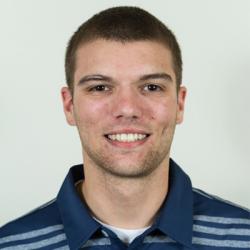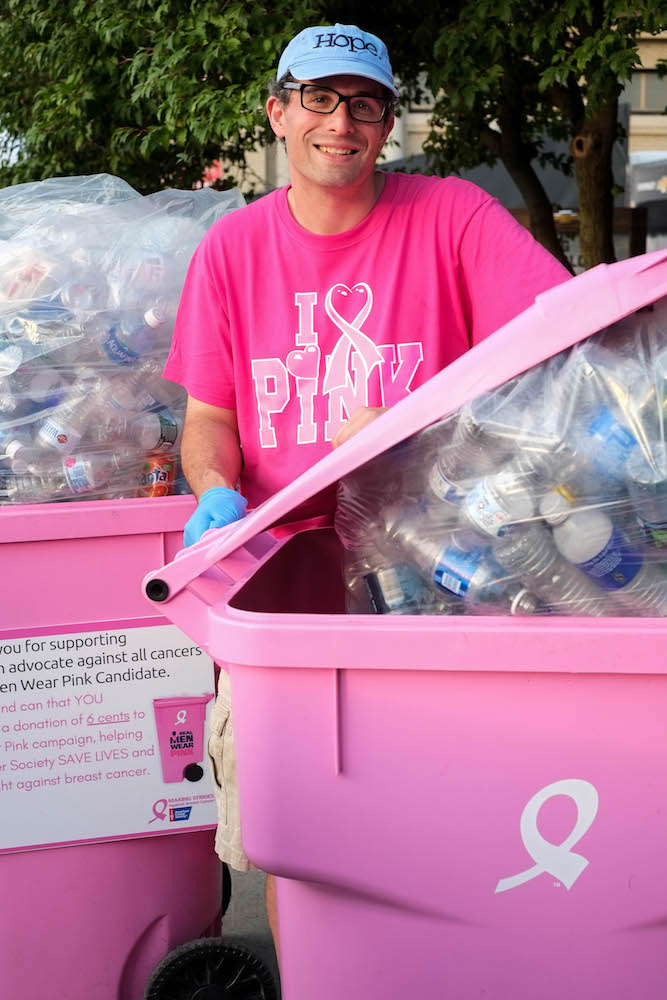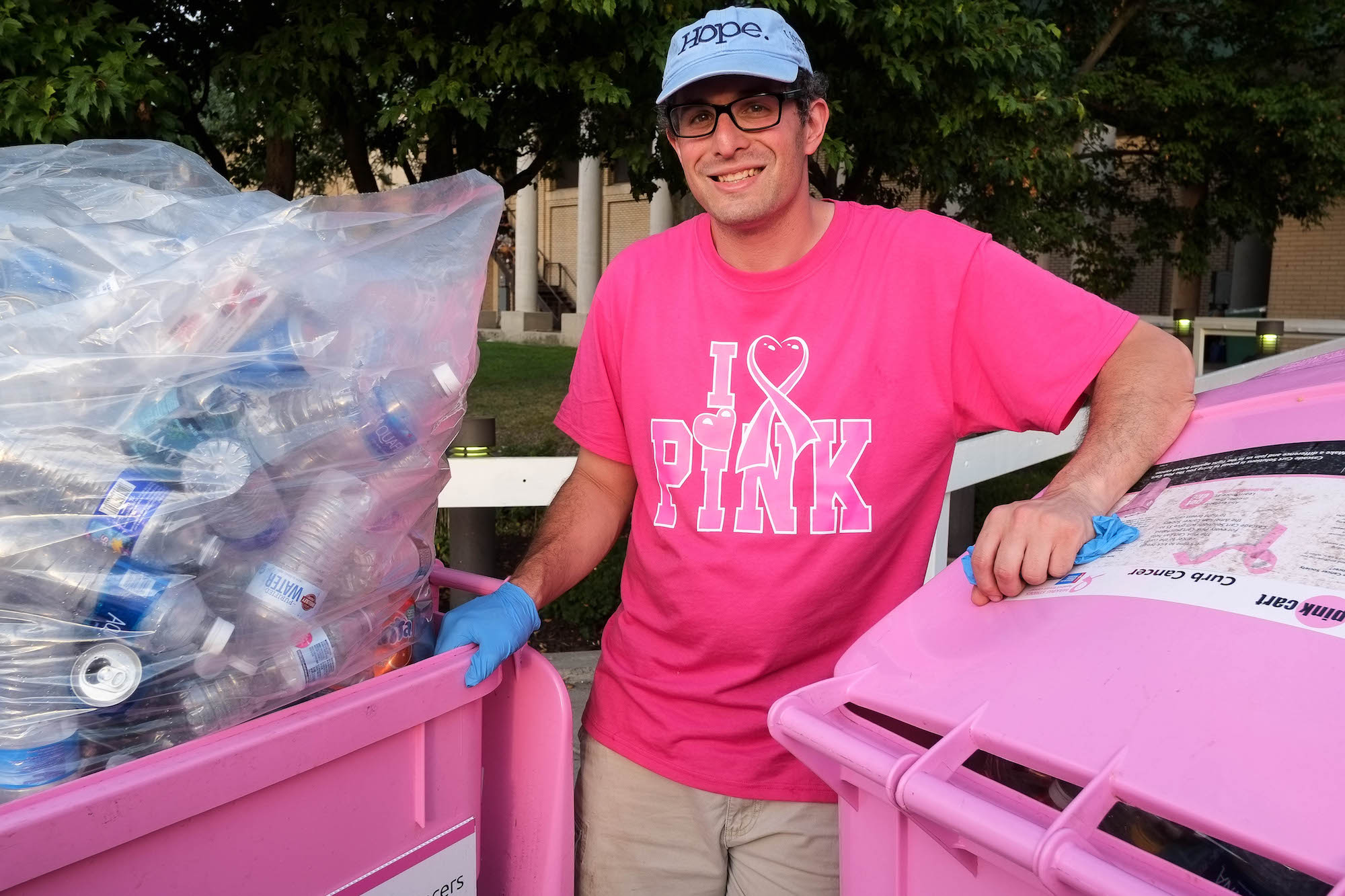
You’ve probably seen Laurence Segal around town. He’s the guy who hauls those big, pink recycling bins around Central New York, including stops at the recent New York State Fair — all 13 days of it — and at Destiny USA.
Segal, who grew up and lives in DeWitt, is out collecting empty cans and bottles, much of the time retrieving them from recycling bins, to raise money for breast cancer research. It’s an arduous task, but it doesn’t deter the activist. “I hope it shows people that they can make a difference,” Segal said.
Segal will continue making a difference at Cans for Cancer, to be held at the pink parking lot at Destiny USA on Oct. 28, 7 a.m. to 3 p.m., as part of October’s Breast Cancer Awareness Month. The inaugural event, spearheaded by Segal, brings together the three main organizations he has donated to over the years: the Upstate Cancer Center, the American Cancer Society and the Carol M. Baldwin Breast Cancer Research Fund.
Segal hopes for a large turnout of donated bottles and cans. As an incentive, everyone who donates to the cause will receive a coupon book to use at various businesses in the mall.
After the large-scale Cans for Cancer drive has passed, Segal said he will go back to raising money by himself, hopefully with some newfound participants who were inspired by the event. “Breast cancer doesn’t just go away at the end of October,” Segal said. “It’s to encourage people to bring your bottles and cans throughout the year after this.”
How did you get started collecting bottles?
It’s because of my family’s history of breast cancer: my grandmother, my great-grandmother, my aunts; my great-aunt had colon cancer. Back in 1987, my mom decided to remove both of her breasts. She met with people in Washington, D.C., and in New York City, and, given her health risk for getting breast cancer, they guaranteed her that she would have it.
It was a difficult decision at the time. When my mom did it, people ostracized her and made fun of her. When Angelina Jolie did it (years later), Beth Baldwin (from the Carol M. Baldwin Breast Cancer Research Fund) looked at me and said, “They look at her like she’s a hero.” Then she went on a campaign to educate people about breast cancer research, early detection, awareness.
She had complications over the years from that. She’s had several stays at the hospital with almost literally near-death experiences — not from cancer but from her implants leaking.
So the bottle and can drive came out of that. When the Simone family was still at the Syracuse Chiefs, I began to notice around NBT Bank Stadium all of the bottles and cans being thrown in the garbage every night, and it upset me. I said to them, “Do you think we could raise some money for cancer research?” And they said, “Yeah, go for it.” We had a giant pink cart at the top of the stairs, which I ran every night with my friend Jon, and we raised a ton of money for cancer research.
Where do you store all of the bottles?
I have a bottle recycling room at Destiny, and I also keep my pink garbage cans in there. So we bring the bottles back there. My friend James (Ayers) owns Bottles End on Montrose Avenue in Solvay, and we come and pick them up, or sometimes I’ll put some in my truck and bring them down there. There have been times when it’s built up like crazy, then it takes five people to go empty out the room.
Where do you store them after local events?
At the State Fair, for example, people saw (Segal’s recycling story) on the news, and they brought their bottles and cans from home into the fair, and we’d bag them. I’d keep them at the booth stacked high at the Center of Progress Building. In addition, we also pull off all of the pop tabs on every can and I donate all of the pop tabs to the Ronald McDonald House every week. The aluminum in the can has value in it.

Laurence Segal: “I’ve made people aware of early detection, we’ve raised awareness for breast cancer and for all of cancer. I think it’s been effective. I know we’ve certainly helped the environment.” Michael Davis photo
You started out exchanging the bottles at Wegmans.
I still sometimes go there if I have tons of bottles. Typically, 99 percent of the bottles now go to Bottles End just because it makes my life easier. I just really like how James is as a human being. He’s had people in his family who have had cancer. I also use my friends at Bodow Recycling on Park Street and Hiawatha Boulevard. Bodow Recycling and Bottles End have just been faithful, loyal and really good.
How did you get involved with the Carol M. Baldwin Breast Cancer Research Fund?
Carol Baldwin and my mom founded the local chapter of the Susan G. Komen Foundation years ago. They’re the ones that started the original walk-run in Shoppingtown. They’re the ones who went to Washington, D.C., to meet with Congress back in late 1989 to 1990, with the idea of helping women and men who were facing breast cancer. Now everybody knows about it, but back then it wasn’t spoken about.
When Carol Baldwin started her own fund around 1996, I sort of became directly involved with that. She calls me her fifth son. I’m close to all of the family members. I like that the money that’s raised stays locally. Their motto is “Together We’ll Find A Cure,” and I think that’s how you have to do it. It’s a collaborative effort with all of New York state, all of Central New York. It requires people to contribute every day and to be aware.
How much have you raised as of now?
We have donated more than $50,000 to the Carol Baldwin Breast Cancer Research Fund. Last year I did another $14,500 for the American Cancer Society, and right now we’ve done more than $5,000 from my Real Men Wear Pink campaign. It’s basically a group of men in the community saying they understand that not only (women) can get breast cancer.
How do you decide which cause to donate to?
I donate to Carol Baldwin and American Cancer Society. We’ve also donated some to the St. Baldrick’s Foundation (a fundraiser for children with cancer). We’ve looked at charities that will keep the money locally. A lot of it goes to Upstate Cancer Center. That’s important. I like the work that they’re doing there.
Whom have you met on this journey?
I met a woman named Rose Fazio out in Chittenango, who literally is disabled, and she was on her hands and knees, crawling. But she saved bottles for a year out there at her house. She called me again this year and said, “It’s Rose Fazio. Do you remember me?” She’s had tragedy in her family; her daughter has been sick. Yet selflessly, she donated a whole garage (of cans and bottles).
I remember people that I’ve met at the fair who are going through breast cancer who were so sick. I’ve met people at Wegmans who donated their (bottle return) slips. People would come up to me and hand me a $5 bill when I was (collecting bottles) at Delta Sonic car wash in the middle of the cold. I’ve met amazing people who understand what I’m doing and who have selflessly donated and have not bragged to anybody else what they’ve done. It’s not about me, it’s about them caring enough to care about other people.
How are you able to devote so much time to raising money for cancer research?
I worked on The Price Is Right (as a production assistant) with Bob Barker and announcer Rod Roddy for several years (in the 1990s and early 2000s) in Los Angeles. When Rod passed away from cancer, he left me a good amount of money. So I invested it wisely, and I pretty much devote my whole life now to raising funds for cancer research.
I was on that stage every day for years during the tapings. I was involved with writing scripts, picking contestants, everything. Behind the scenes, I stood next to Rod on stage every day. In April 2001, he started having pain during a show. I said, “Are you OK? Do you want me to call an ambulance?” And he said, “Absolutely not. I want to finish the show.”
He went to the hospital after the show and discovered he was anemic, and they started running tests. On Sept. 10, 2001, they did a colonoscopy and discovered he had metastatic colon cancer, and he had emergency surgery on the 9/11 for seven and a half hours. A doctor from the John Wayne Cancer Institute saved his life that day on Sept. 11. He had radiation and chemo following that and another surgery on Sept. 20, 2002. Then he was diagnosed with primary male breast cancer on March 14, 2003.
The summer of 2003 was brutal. I stayed with him the whole time in the hospital in addition to working on The Price Is Right. I went to chemo, I went to radiation, I stayed with him right until the day he died. It was a life-changing experience. He was my best friend, a wonderful person. He promoted early detection at the end of his life: mammograms, colonoscopies. I learned all about that from him.
I had already had breast cancer impact my life. Nobody else was willing to really go to chemo and radiation with him, and I said, “I’ll go with you.” He died on Oct. 27, 2003, at 3:45 in the afternoon; I was with him. It’ll be 14 years (this month) when I turn 40.
I miss him every day. I regret that he wasn’t diagnosed properly and early. The colon cancer, certainly. He put off having a colonoscopy for 13 years. The breast cancer came out of left field and just showed up. He also had prostate cancer that he had been diagnosed with early in 2001, but he hadn’t told anybody.
Part of this bottle drive and raising funds for cancer research is to honor him. I just think it’s a waste of a life, as are all (cancer-related deaths). It shouldn’t happen in 2017. We need more early detection. People always say to me, “Well, why do we need cans and bottles? There’s enough dollars for research.” And I always say, “Obviously not.” Cancer doesn’t discriminate: Black or white, rich or poor, young or old, it’s a horrible disease.
You herniated some discs in your back a couple of months ago. How is your back doing?
I saw a great physical therapist, and I’ve had some acupuncture done. I was in very bad shape. It’s better now, but I still have pain every day. I’ve gone back to collecting bottles — slowly. I’m very careful in the way I reach into the cans and careful how I bend my knees. I’m not leaning over.
What kinds of bottles do you see the most?
People always say that the economy stinks, and I always laugh. I can tell you that Coca-Cola is not going out of business, neither is Pepsi, neither is Budweiser. To be honest, I see water bottles the most. Ever since the water bottle bill went into effect in 2008, I see a ton of Wegmans bottles, Aldi bottles, Price Chopper bottles.
Sadly, I also see a lot of beer cans. I say sadly because I always hear there’s no money for cancer research, yet people have all this money to buy premium alcohol, which costs all of this money. So if they have money for alcohol, they probably have money to donate to cancer research. I see tons of Budweiser cans, Coors Lite, Miller Lite.
A better bottle bill needs to be passed for all of New York state. It’s silly to throw one type of bottle in the garbage and recycle another type. I say to New York state, Why are only certain cans recyclable? They say, “Oh, because it’s carbonated and this one’s not.” It doesn’t make a difference. A bottle is a bottle, plastic is plastic, a can is a can.
I see a lot of 1911 (cider), AriZona (iced tea), Monster (energy drink), and I see a ton of Gatorade and Powerade, too, which is why a better bottle bill needs to be passed.
What do you do with the bottles that aren’t recyclable?
I’ll bring them down to James. There’s a company that picks them up from him. But essentially there can’t be a donation made at that point for research. He gets a small amount from the recycling company to take those bottles. So are they getting recycled somewhere or another? Yes. But there should be a better bottle law, and it should cover everything. They do it in Maine, California, Hawaii. It’s non-excusable that it doesn’t happen here.
I’ve met with people in Gov. Andrew Cuomo’s office and we’re going to have to go back and lobby some more, but I’m willing to do it. You just have to convince Democrats and Republicans to come together (laughs), that it’s for the betterment of the state and to pass the law. We’re closer than we were before, and they understand.
Have you accomplished what you initially set out to?
I’ve made people aware of early detection, we’ve raised awareness for breast cancer and for all of cancer. I think it’s been effective. I know we’ve certainly helped the environment.
The bottles and cans don’t really mean anything to me. It just represents another 6 cents for cancer research. I hope, if anything, they represent hope and inspiration.
People always go, “Why bottles and cans?” Well, it’s just to show people how much money is thrown away in Syracuse every day. I see it every day, no matter what gas station I go to, whether it’s vacuumed up at Delta Sonic every day, or it’s thrown away in the garbage. All of that money could go to cancer research. So I hope that point gets through to people.
How long will you continue to do this?
I’m going to go for as long as my health allows me to, and after that, I think I have a significant amount of people now, like almost my own little army, that will go out there and fight for it. I know people who will donate their time, no matter what.
My goal doesn’t necessarily have to be with bottles and cans. If some business wants to come forward and make a big donation to cancer research, I’d love it. Delta Sonic did that last year; they made a $10,000 donation to Carol Baldwin in my name. So if a business thinks cancer research is worthwhile, and they want to make a tax-deductible donation and say, “Hey, I like what Laurence is doing,” I’m all for it. I want it to happen around the country.
There’s plenty of money for cancer research because it exists. I encourage people, don’t throw money in the garbage. I just think that’s crazy.
[fbcomments url="" width="100%" count="on"]







